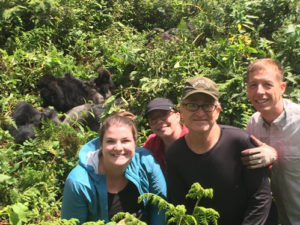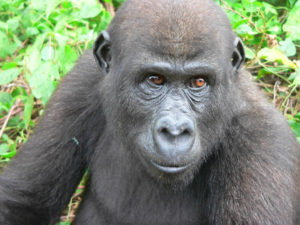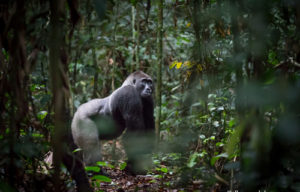Where are gorillas found in Africa? Of all wild primates, gorillas are arguably the most intriguing. They are the larger and more powerful yet very gentle creatures. Gorillas are special because they behave like we humans and share more than 97% of our genetic code. Chimpanzees may be more clever and intelligent but they are too aggressive/disorganized compared to gorillas. Gorillas can generally be described as wiser, charismatic and benevolent.
 Gorillas are only native to Africa and there are two main species – The western gorilla and the Eastern gorillas. Western gorillas are further dived into two sub-species, the Cross river gorilla and the western lowland gorilla. Eastern gorillas are divided into Mountain gorillas and Eastern lowland gorillas ( Grauer’s gorilla). The western lowland gorilla is the most common with an overall population of over 250,000.
Gorillas are only native to Africa and there are two main species – The western gorilla and the Eastern gorillas. Western gorillas are further dived into two sub-species, the Cross river gorilla and the western lowland gorilla. Eastern gorillas are divided into Mountain gorillas and Eastern lowland gorillas ( Grauer’s gorilla). The western lowland gorilla is the most common with an overall population of over 250,000.
Scientists believe that western gorillas were separated from eastern gorillas during the ice age. The cold conditions and ice caused rain-forests to shrink into smaller forests separated by savanna. After the ice age, rain forest once again spread around the tropics. By this time the western and eastern gorillas had been apart for too long and had started following a different development path physically and genetically. Despite a few differences, all gorilla species share one thing in common. They have broad shoulders/chests and larger forearms/hands. Their eyes are close together, the face hairless and the nostrils large/prominent. The Eastern gorillas are larger than the western gorillas and have darker and longer fur. An adult male gorilla can weigh up to 200 kilograms.
 Gorillas are mostly vegetarian and feed mostly on bamboo shoots, tree stems/bark, fruits and rarely on termites. Gorillas live in relatively stable groups headed by a dominant Silverback. Gorilla groups can contain between two to 50 members. The dominant male determines where to feed and rest. He keeps a keen watch on all members of the group and will protect his family from other silverback gorillas, other animals or humans. The dominant male rules until he dies or is replaced by a stronger male within or from other groups. Males become sexually mature at about 15 years and the dominant silverback has all mating rights in a gorilla group. The females generally leave a group once they reach maturity to join a single male or other groups. Although females are sexually mature at 8 years, they start breeding later on. There are rare cases of females reproducing in their own group especially among cross river gorillas. A female will give birth to about four young in her life. Gorillas can live up to about 40 years old in the wild and 50 in captivity.
Gorillas are mostly vegetarian and feed mostly on bamboo shoots, tree stems/bark, fruits and rarely on termites. Gorillas live in relatively stable groups headed by a dominant Silverback. Gorilla groups can contain between two to 50 members. The dominant male determines where to feed and rest. He keeps a keen watch on all members of the group and will protect his family from other silverback gorillas, other animals or humans. The dominant male rules until he dies or is replaced by a stronger male within or from other groups. Males become sexually mature at about 15 years and the dominant silverback has all mating rights in a gorilla group. The females generally leave a group once they reach maturity to join a single male or other groups. Although females are sexually mature at 8 years, they start breeding later on. There are rare cases of females reproducing in their own group especially among cross river gorillas. A female will give birth to about four young in her life. Gorillas can live up to about 40 years old in the wild and 50 in captivity.
With a population of over 250,000, western lowland gorillas are the most numerous and widespread. They face the greatest persecution because of their constant encounters with humans. After them are the eastern lowland gorillas which number about 7,000. Mountain gorillas may have shown the greatest percentage increase in numbers but their overall population is one of the lowest at about 1,000. At the bottom of the curve are the Cross river gorillas in Nigeria and Cameroon. Only about 250 Cross river gorillas can still be found in the wild.
The overall population of gorillas has reduced significantly in the last few decades. Most of the species are now listed as critically endangered or threatened due to hunting, diseases, war/instability, animal trafficking and habitat loss (due to mineral exploration and logging). In order to protect these great apes from total extinction, a collaborative effort involving governments and wildlife conservation Agencies is important. The primates can be protected by stopping illegal trade in baby gorillas, stopping forest encroachment and eliminating poaching. Both international and local communities should be involved in the conservation efforts to help generate funds and create shared responsibility. It is also important that all gorilla conservation efforts should be part of wider wildlife conservation plans to realize greater success. You might be interested in an article about the essential packing list for a safari in Africa.
Where do gorillas live in Africa?
Wondering where to see gorillas in the wild? Wild gorillas live in the forests of east and central Africa – Angola, Cameroon, Central African Republic, Congo, Democratic Republic of Congo, Equatorial Guinea, Gabon, Nigeria, Rwanda and Uganda. Although most tourists head to Uganda and Rwanda for gorilla tracking, the countries in West Africa offer even more amazing adventures for primate lovers. If you can tolerate the discomfort, unpredictability and long traveling distance in some of the countries in West Africa, you will be rewarded with amazing biodiversity. We will now discuss the different countries where gorillas are found. You can read a separate article about the best places for wildlife viewing in Africa.
Where to see gorillas in Rwanda
Rwanda is one of the best places to see gorillas in the wild. Rwanda is home to about 30 percent of the remaining population of mountain gorillas. All gorillas of Rwanda are found in the Volcanoes National Park of Rwanda. This is where the famous primatologist Dian Fossey established base in the 1960’s to study the behavior of these majestic creatures. Gorilla trekking in Volcanoes National Park is very popular and attracts thousands of visitors to the country every year. There are ten habituated mountain gorilla groups in Rwanda at the moment. Rwanda is thought to be the most convenient place to spot mountain gorillas in the world. Rwanda is perfect for seeing gorillas because of well-developed tourism infrastructure and comparably more professional services. The chances of seeing gorillas in Rwanda is over 99%. Gorilla permits in Rwanda are the most expensive at $1500 apiece.
Where to see gorillas in Uganda
Uganda is one of the best places to see mountain gorillas. Half of the overall population of mountain gorillas are found in Uganda and in two national parks – Bwindi Impenetrable national park and Mgahinga National Park. Mgahinga National Park has only one habituated gorilla group while Bwindi has 17. The mountain gorillas in Mgahinga live in relatively high altitudes while those in Bwindi prefer lower land. Because of the high numbers, many of the gorilla groups in Uganda remain wild. Uganda also stands out as the only country where one can take part in the gorilla habituation experience. This unique experience involves observing the primates for about 4 hours compared to standard gorilla trekking where tourists are only allowed one hour with a gorilla group. Uganda is also blessed with a greater variety of wildlife and activities which visitors can get involved in after seeing the gorillas. Uganda is arguably the better destination for gorilla trekking but the government isn’t as aggressive in promoting the activity as Rwanda. The driving distance from the capital Kampala or Entebbe to Bwindi or Mgahinga is very long hence discouraging some tourists. Many prefer crossing to Uganda from Rwanda to avoid the long driving distance. The chances of seeing mountain gorillas in Uganda is very high (over 99%). Gorilla permits in Uganda cost $700 and hence an excellent destination for budget gorilla trekking.
Where to see gorillas in Congo
Civil war and political instability has often denied the world access to a country with arguably the greatest tourism potential in Africa. The Democratic Republic of Congo is the only country where one can see 3 of the gorilla sub-species. Mountain gorillas can be seen at the Virunga National Park. Eastern lowland gorillas in Kahuzi Biega National Park and western lowland gorillas in the far western part of the country along the Madiakoko Mountains. Because of the insecurity in the Eastern part of the country, gorilla viewing for tourists is only possible in Virunga and Kahuzi Biega National Parks at the moment. The chances of seeing eastern lowland gorillas in Kahuzi Biega and Mountain gorillas in Virunga is very high. The chances of seeing western lowland gorillas is low as they tend to move to Angola and back. Gorilla permits in Congo cost $400.
Seeing Wild gorillas in West Africa
Cameroon: Cameroon is one of the countries in West Africa with western gorillas. The country is home to both western lowland gorillas and the Cross River gorilla. Cross River gorillas live at the border between Nigeria and Cameroon. They are the most critically endangered of all the gorilla subspecies. In fact, it was thought that they had become extinct until only recently. Tourists are not yet allowed to visit Cross river gorillas because there is no habituated group. The only Cross River gorilla in captivity is found at Limbe Wildlife Centre which takes care of orphaned western lowland gorillas. The Western lowland gorillas of Cameroon are found in the Campo-Ma’an National Park. Tourists can see the primates at the national park but the chances of seeing them is less than 70%. The best bet is to visit rescued orphaned lowland gorillas at the Mefou National Park.
 Nigeria: Although the government of Nigeria has invested considerably in tourism, the chances of seeing Cross River gorillas in the wild is very slim because they are not habituated. Moreover, Cross River gorillas have been known to be more aggressive towards humans. Only conservationists and researchers can visit the primates considering that there are less than 300 individuals remaining in the wild. Even if tourists where allowed in, it would be very difficult to find the primates in a short time. They are scattered in an area covering about 2,900 square miles including certain regions of Cross River National Park, Mbe Mountain and Afi Mountain.
Nigeria: Although the government of Nigeria has invested considerably in tourism, the chances of seeing Cross River gorillas in the wild is very slim because they are not habituated. Moreover, Cross River gorillas have been known to be more aggressive towards humans. Only conservationists and researchers can visit the primates considering that there are less than 300 individuals remaining in the wild. Even if tourists where allowed in, it would be very difficult to find the primates in a short time. They are scattered in an area covering about 2,900 square miles including certain regions of Cross River National Park, Mbe Mountain and Afi Mountain.
Central African Republic: The Central African Republic offers one of the best places for tracking western lowland gorillas. The Wild Wildlife Fund (WWF) has set up a gorilla research and habituation programme that has so far succeeded in habituating one group at the Dzanga-Ndoki National Park. There is a high chance of spotting gorillas although taking good photos is a challenge in very dense forest with little light reaching the ground.
Republic of Congo or Congo Brazaville: The Republic of Congo is the best places to spot western lowland gorillas. Odzala National Park has two habituated gorilla groups that are open to tourism but this is only a fraction of the over 22,000 found in the park. The best way to spot them is by staying in hidden enclosures/hides and waiting for them to come out in open clearings (known as Bai). Mbeli Bai is a well-known open clearing where about 100 individuals have been studied by the Wildlife Conservation Society for over ten years.
Apart from these forest clearings, gorilla families can also be observed foraging in marshes and swamps for water plants in the company of other animals (buffaloes, swamp antelopes and elephants). One other place to spot the western lowland gorilla while in Congo Brazaville is at the Léfini Reserve. This reserve is found in an island hence allowing visitors to spot the gorillas while on a boat. Regardless of where you choose to search for the gorillas in the Republic of Congo, expect to discover pristine and untouched wilderness. Gorilla permits in Odzala National Park cost $355 per person.
Gabon: With over 12 national parks to its name, Gabon is a great destination for wildlife enthusiasts. Unfortunately, gorilla trekking is not yet well developed in Gabon even though most of the national parks have western lowland gorillas. Moukalaba-Doudou National Park has one of the largest population of gorillas in Africa. The park stands out because of sheer density of primates. An ecotourism project was started with the intention of allowing tourists to visit these primates. Tourist can now go and track the primates deep into the jungle on foot.
 There was also a habituation programme for Western lowland gorillas in Lopé National Park but it ended without success. The only way to view the gorillas in Lopé National Park is while on a safari to see other wildlife. Loango National Park is also a great habitat for western lowland gorillas. It is a unique national park with great biodiversity spreading all the way to the Atlantic Ocean. It offers a combination of forest and marine life allowing tourists to spot dolphins, whales, hippos along the ocean shores or go into the forest to see chimpanzees, forest elephants and gorillas.
There was also a habituation programme for Western lowland gorillas in Lopé National Park but it ended without success. The only way to view the gorillas in Lopé National Park is while on a safari to see other wildlife. Loango National Park is also a great habitat for western lowland gorillas. It is a unique national park with great biodiversity spreading all the way to the Atlantic Ocean. It offers a combination of forest and marine life allowing tourists to spot dolphins, whales, hippos along the ocean shores or go into the forest to see chimpanzees, forest elephants and gorillas.
Equatorial Guinea: Equatorial Guinea is one of the last remaining strongholds of the western lowland gorilla. The primates are found in Monte Alen National Park but gorilla tourism is not yet well developed and there is no habituated gorilla group in a park with very dense forest. The good news is that a few trained locals now conduct daily treks with tourist to the forest. If you are the adventurous type and want to do something truly special, then you should show up in the area and contact the locals about how to see gorillas.
Angola: Last but not least, western lowland gorillas can also be seen in Angola. They live in the northern part of the country and in only one location – the Cabinda enclave near the River Congo. If you are planning to see the gorillas in Angola, you need to know that gorilla tourism is not well organized and the chances of seeing the primates is low as we write this article.

